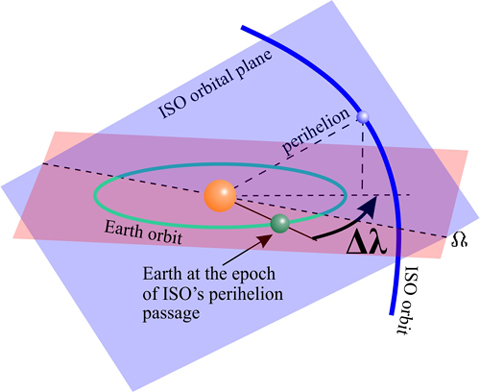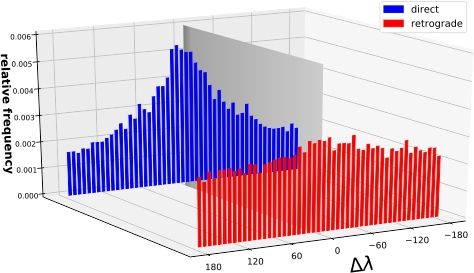Can Holetschek’s effect provide a tool for estimating size-frequency distribution of interstellar objects?
- University of Belgrade, Faculty of Mathematics
1. Introduction
To estimate a size-frequency distribution (SFD) of any population of small bodies it is necessary to compensate the observational selection effects, which generally favor larger and brighter objects. For a mixed population, made up of asteroids and comets, as expected for the population of interstellar objects (ISOs), the discovered population should be also significantly biased toward cometary objects, which makes it difficult to estimate even the basic properties of this population. Therefore, the ISO SFD was completely unconstrained [1], until very recent work by Bolin et al. [2].
We have investigated the orbital distribution of ISOs, observable by the future wide-field National Science Foundation Vera C. Rubin Observatory (VRO). The results show that among the asteroidal ISOs, there should be an excess of retrograde orbits among the observed objects [3]. We found that this may be due to the observational selection effects, known as Holetschek’s effect [4]. Interestingly, a level of retrograde orbit excess depends on the SFD of the ISOs, suggesting that the ratio between the prograde and retrograde ISOs observable by the VRO could be used for estimation of the SFD of the underlying true population.
2. Holetschek’s effect
According to this effect, objects which reach perihelion on the side of the Sun opposite to the position of the Earth are less likely to be discovered. This is because in this configuration objects are both, too close to the Sun (small elongation), and further away from the Earth (fainter). Therefore, a probability for an object to be discovered depends on the difference Δλ between the heliocentric longitude of the Earth and that of the object at the time of the perihelion passage of this object. This is illustrated in Fig. 1.

Figure 1 - Constellation related to Holetschek’s effect. Quantity Δλ is the difference between the heliocentric ecliptic longitudes of an interstellar object and the Earth, at the epoch of the object’s perihelion passage.
3. Orbital distribution of ISOs
To investigate the influence of Holetsechek’s effect on ISOs, we generate their synthetic population and simulate their ephemerides over a period of 10 years, in order to select those which may be observed by the VRO, based on the nominal characteristics of this survey. We found that Holetschek’s effect is more pronounced for objects on prograde than for those on retrograde orbits. This is obvious from Fig. 2 in which are shown distributions of Δλ separately for prograde and retrograde objects.

Figure 2 - The normalized histograms of Δλ of the detectable objects. The figure shows separately objects on direct (i<90 deg) and retrograde (i>90 deg) orbits. The vertical plane denotes objects which pass through their perihelions while they are on the same heliocentric ecliptic longitude as the Earth. The observed asymmetry is likely due to Holetschek’s effect.
4. Future prospect
Different sensitivity of prograde and retrograde objects to the effect results in asymmetry of distribution of the orbital inclinations of the detectable population. On the other hand, Holetschek’s effect mostly affects small bodies, while for larger objects (of the order of several km) it is almost negligible. Since populations with steeper size distribution have larger portion of small objects, they are more subjected to this effect, resulting in a more pronounced asymmetry of the distribution of orbital inclinations. Our results show that a retrograde/prograde orbits ratio and median orbital inclination of the detectable population is correlated with the SFD slope of the generated population of ISOs. Therefore, these parameters of the discovered population of ISOs could, in turn, be used to estimate the SFD of the underlying true population. Alternatively, based on an available estimation of the SFD of interstellar objects [2], the expected excess of retrograde orbits could be calculated.
References:
1. Engelhardt T., Jedicke R., Vereš P., Fitzsimmons A., Denneau, L., Beshore E., Meinke B.: 2017, AJ, 153, 133
2. Bolin B.T., et al., 2020, AJ, 160, 26
3. Marčeta D., Novaković B., 2020, MNRAS, doi:10.1093/mnras/staa1378 (arXiv:2005.10236)
4. Holetschek J., 1891, Astronomische Nachrichten, 126, 75
How to cite: Marceta, D. and Novakovic, B.: Can Holetschek’s effect provide a tool for estimating size-frequency distribution of interstellar objects?, Europlanet Science Congress 2020, online, 21 September–9 Oct 2020, EPSC2020-787, https://doi.org/10.5194/epsc2020-787, 2020

